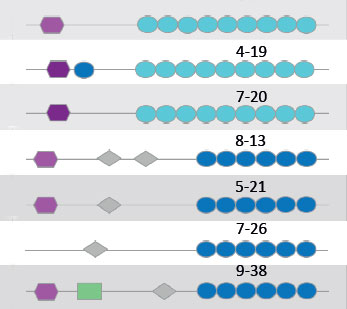Eukaryotic genes in vacuolar pathogens and symbionts (EUGENPATH)
Intracellular bacterial pathogens and symbionts maintain intimate interactions with their eukaryotic hosts, which have been shaped by mutual trans-kingdom co-evolution over extended periods of time. To adapt to their intracellular niches, these bacteria acquired and functionally integrated genes from their unicellular hosts. Eukaryotic genes present in bacterial genomes, here termed “EUGENs”, represent a hallmark of intracellular bacteria, and are rarely if at all present in free-living bacteria. Thus, EUGENs are expected to define intracellular parasitic or symbiotic bacterial life styles, yet it is currently largely unknown to what extent and how.
 The genomes of members of the families Legionellaceae, Coxiellaceae and Parachlamydiaceae harbor dozens if not hundreds of EUGENs. Many EUGEN products are “effector” proteins that are translocated into host cells through dedicated type III or type IV secretion systems, and some have indeed been shown to interfere with host vesicle trafficking or signal transduction pathways. Yet, most EUGENs and their products have not been functionally studied on a molecular and cellular level. In this project we will investigate the role of distinct EUGENs in Protochlamydia symbiosis.
The genomes of members of the families Legionellaceae, Coxiellaceae and Parachlamydiaceae harbor dozens if not hundreds of EUGENs. Many EUGEN products are “effector” proteins that are translocated into host cells through dedicated type III or type IV secretion systems, and some have indeed been shown to interfere with host vesicle trafficking or signal transduction pathways. Yet, most EUGENs and their products have not been functionally studied on a molecular and cellular level. In this project we will investigate the role of distinct EUGENs in Protochlamydia symbiosis.
The comparative analysis of distinct groups of EUGENs and their products from different groups of intracellular bacteria, this collaborative effort in the context of the ERA-NET Infect-ERA will (i) provide mechanistic insights into parasitic and symbiotic processes, (ii) contribute to elucidating the relationship between parasitism and symbiosis, and (iii) establish a link between bacterial virulence or symbiosis and intracellular bacterial metabolism.
Infect-ERA partners: Hubert Hilbi (coordinator, University of Zürich), Carmen Buchrieser (Institut Pasteur), Gil Segal (Tel-Aviv University), Matteo Bonazzi (CNRS), Dörte Becher (Ernst-Moritz-Arndt University Greifswald)
 This project is funded by the Austrian Science Fund FWF (I 291-B09).
This project is funded by the Austrian Science Fund FWF (I 291-B09).



